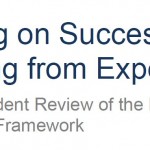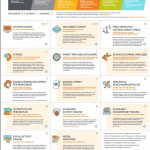 The Stern review of the REF was published in July 2016. The government have accepted the main recommendations, and we are expecting in November a HEFCE technical consultation on implementation – to affect the next REF exercise (probably in 2021). It is expected that the new arrangements will be settled by the summer of 2017.
The Stern review of the REF was published in July 2016. The government have accepted the main recommendations, and we are expecting in November a HEFCE technical consultation on implementation – to affect the next REF exercise (probably in 2021). It is expected that the new arrangements will be settled by the summer of 2017.
So what did Stern recommend – and what is likely to be in the consultation?
- The main thing that Stern might have done, but did not do – following widespread concern in the sector – was move to a metrics-based approach for the REF. Peer review and case studies will remain and there will be an opportunity to celebrate success wherever it is found in the REF – not a metrics based ranking. There may be new metrics, and a new Forum for Responsible Research Metrics has been launched, but the key is that these metrics should be used responsibly and carefully.
- All research active staff should be returned in the REF (and allocated to a unit of assessment).
- Outputs should be submitted at Unit of Assessment level with a set average number per FTE, but with flexibility for some faculty members to submit more and others less than the average. A total cap should be set based upon two outputs on average per FTE with an individual cap (e.g. six) and a minimum per FTE (potentially 0).
There has been some concern expressed about these changes – Maddalaine Ansell (University Alliance) via Wonkhe and James Wilsdon in The Guardian, 29th July 2016. At BU, our strategy is that all academic staff should be active in research as part of Fusion, so we will not be moving towards teaching only contracts. We hope the sector will not do so either – we will consider pressing for all staff to be included and remove any risks around the definition of “research active” to avoid this
- The total number of outputs per UoA should be adjusted so that it does not significantly exceed the 190,000 reviewed in REF2014. This may require the average number of outputs submitted per faculty member to be below two.
- Outputs should not be portable. The review proposes that outputs should be submitted by the HEI where the output was demonstrably generated and that work should be allocated to the HEI where they were based when work accepted for publication. There may be some flexibility around maximum numbers when staff have moved- e.g. maximum three outputs from those who have left.
Concern has been expressed that this will restrict employment options for early career researchers, e.g. Paul Kirby. James Wilsdon again “the broader move to reduce output numbers and decouple them from individuals should reduce pressure on those at the start of their career, or who take time out of research because of childcare, illness or caring responsibilities” Other views: – it might be fairer to early career researchers who will be recruited on potential not previous publications
- Institutions should be given more flexibility to showcase their interdisciplinary and collaborative impacts by submitting institutional level impact case studies
- Impact should be based on research of demonstrable quality. However, case studies could be linked to a research activity and a body of work as well as to a broad range of research outputs
- Guidance on the REF should make it clear that impact case studies should not be narrowly interpreted, need not solely focus on socioeconomic impacts but should also include impact on government policy, public engagement and understanding, cultural life, academic impacts outside the field and impacts on teaching – the report recommends that research leading to impact on curricula and/ or pedagogy should be included. BU welcomes these changes and we look forward to seeing more details of these plans.
So watch this space – once the consultation is launched the Research and Knowledge Exchange team will be working with the policy team to prepare a BU response. You can read more about BU’s policy and public affairs work on our intranet pages.
 Lord Stern’s REF Review- the outcome
Lord Stern’s REF Review- the outcome Research Impact Metrics – useful reference cards
Research Impact Metrics – useful reference cards










 BU attendance at third annual GCPHR meeting in June
BU attendance at third annual GCPHR meeting in June Interactive Tangible and Intangible Heritage Applications – BU student work featured in new book chapter
Interactive Tangible and Intangible Heritage Applications – BU student work featured in new book chapter Second NIHR MIHERC meeting in Bournemouth this week
Second NIHR MIHERC meeting in Bournemouth this week MSCA Postdoctoral Fellowships 2025 Call
MSCA Postdoctoral Fellowships 2025 Call ERC Advanced Grant 2025 Webinar
ERC Advanced Grant 2025 Webinar Horizon Europe Work Programme 2025 Published
Horizon Europe Work Programme 2025 Published Horizon Europe 2025 Work Programme pre-Published
Horizon Europe 2025 Work Programme pre-Published Update on UKRO services
Update on UKRO services European research project exploring use of ‘virtual twins’ to better manage metabolic associated fatty liver disease
European research project exploring use of ‘virtual twins’ to better manage metabolic associated fatty liver disease